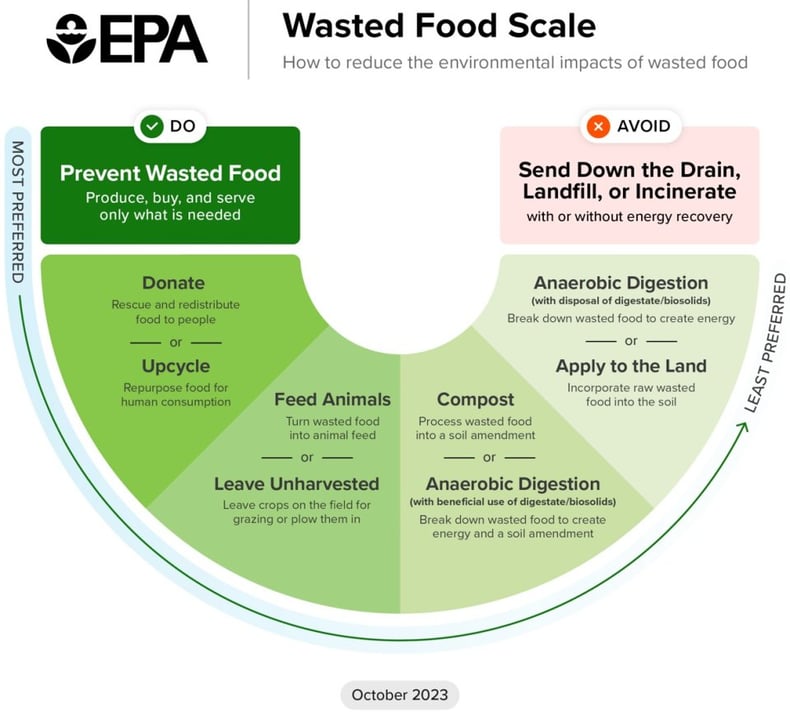Updating the Food Waste Hierarchy, elevating prevention

Earlier this month, the US EPA’s food recovery hierarchy, the upside down triangle which has guided food waste reduction efforts since the 1990s, got a makeover.
And that’s a good thing, as it reflects the continued evolution of research and elevation of activity on food waste reduction.
As we know, EPA’s hierarchy ranked food waste reduction actions from most environmentally preferred to least preferred, with source reduction (aka prevention) at the top, followed by feeding people, feeding animals, industrial uses, composting, and landfill.
The well-known triangle has been replaced by the Wasted Food Scale, a new shape with expanded pathways for managing excess food along with intentional color coding to highlight solutions from most-preferred to least-preferred.
The new scale provides more granularity in defining 11 wasted food pathways – with prevention ranked at the top left (visually notable as the most preferred solution with the boldest shade of green), followed by donation and upcycling in the next most-preferred tier.
Subsequent tiers include pathways for feeding animals, leaving land unharvested, composting, anaerobic digestion (with or without use of digestate), land application, and sending food down the drain (sewer/wastewater treatment), landfilling, or incineration (with or without energy recovery). Pathways are ranked equally within each tier.
With the new scale, EPA emphasizes that the most preferred solutions – prevention, followed by donation and upcycling – provide the most environmental (better said, societal) and circular economy benefits. These are clearly noted as “Do.” In addition, the phrasing at the top is more effective: “source reduction” has been replaced by “prevent wasted food.”
On the opposite end of the scale, landfilling, incineration, and wastewater disposal are clearly noted as least preferable, highlighted with a red color code to “Avoid.”
EPA’s research leading to the development of the scale and the expanded pathways, along with associated life cycle and circularity assessments, can be viewed in the new report: From Field to Bin: The Environmental Impacts of U.S. Food Waste Management Pathways – Part 2.
Significantly, this report notes that “source reduction is fundamentally distinct from all the other wasted food management pathways” due to the fact that wasted food is not generated, thus preventing food from being wasted at any point in the supply chain.
This concept has been core to Leanpath’s mission of making food waste prevention everyday practice in the world’s kitchens for 20 years.
Further, the report emphasizes that source reduction, donation, and upcycling are the most environmentally preferred pathways because of their ability to displace additional food production – thus avoiding all of the environmental externalities of growing, harvesting, distributing, and storing that food.
Importantly, the report highlights that the benefits of downstream solutions beyond source reduction, donation, and upcycling are small relative to the substantial environmental impacts of food production.
A parallel report quantifies methane emissions from landfills, stating that 58 percent of methane emissions escaping to the atmosphere are from food waste, and that methane emissions from landfilled food waste are increasing.
So the need to prioritize the prevention of food waste, and then donating or upcycling any excess food resources that remain, is clear – and we should leverage these and other reports to continue to shift the food waste conversation and reduction efforts upstream for maximum societal impact.
As noted, EPA’s new reporting reflects the positive evolution of research and heightened global awareness that is helping to accelerate that shift.
For example, the new research builds on a preceding report (From Farm to Kitchen: The Environmental Impacts of U.S. Food Waste – Part 1) from 2021 which pointed to the many substantial benefits of halving food loss and waste in the U.S. – such as reducing the environmental footprint of an amount of agricultural land larger than Arizona, saving an amount of water equivalent to the annual use of 29 million American homes, avoiding an amount of CO2 emissions equivalent to the annual generation of 23 coal-fired plants, and more.
Significantly, the 2021 report stated that the above benefits could only be achieved through prevention.
In addition, earlier this year, ReFED released new estimates of U.S. food waste in its Insights Engine, and in that work noted that 83 percent of the GHG benefits from food waste reduction can be attributed to prevention and recovery solutions, with the majority (80 percent) stemming from prevention.
And with the food system accounting for one-third of global emissions annually, food waste prevention has a lot of impact. See our prior post here in which we noted that ReFED’s work reinforced why prevention is the top solution in the Food Recovery Hierarchy, and where it remains today in the newly developed Food Waste Scale.
Last, we are all familiar with the FAO’s landmark 2011 report, Global Food Losses and Food Waste – Extent, Causes and Prevention, which informed the world that one-third of food produced for human consumption is lost or wasted annually.
In recent years, additional research has been conducted on both the food loss and food waste components to provide updated granularity for targeting solutions. One of the reports resulting from this research, the Food Waste Index Report 2021, estimated that 931 million tonnes of food waste were generated in 2021, with 26 percent emanating from foodservice operations.
So we are seeing an important evolution of research as the importance of food waste reduction gains more attention both within the U.S. and on the global stage.
And we now have a new Wasted Food Scale to guide food waste reduction efforts, one which more clearly illustrates the importance of prioritizing the prevention of food waste to maximize societal benefit.
Let’s embrace the new scale and the evolving research, prioritizing food waste prevention for maximum impact in the critical journey to halve global food loss and waste.
Dive Deeper: Download Why Food Waste Should be Your Top Sustainability Initiative